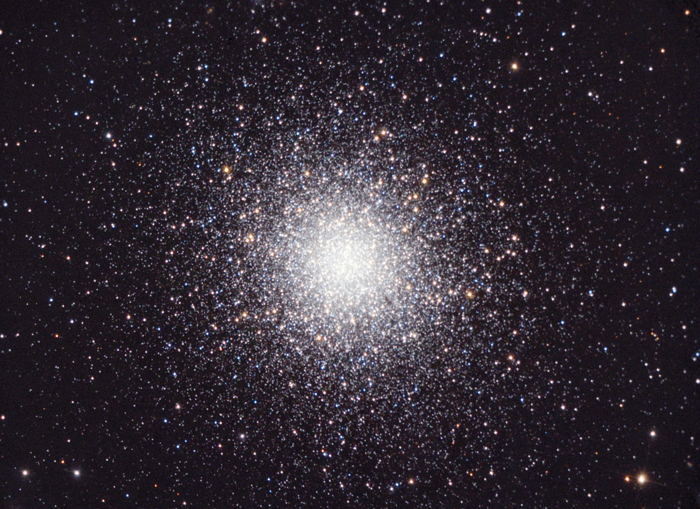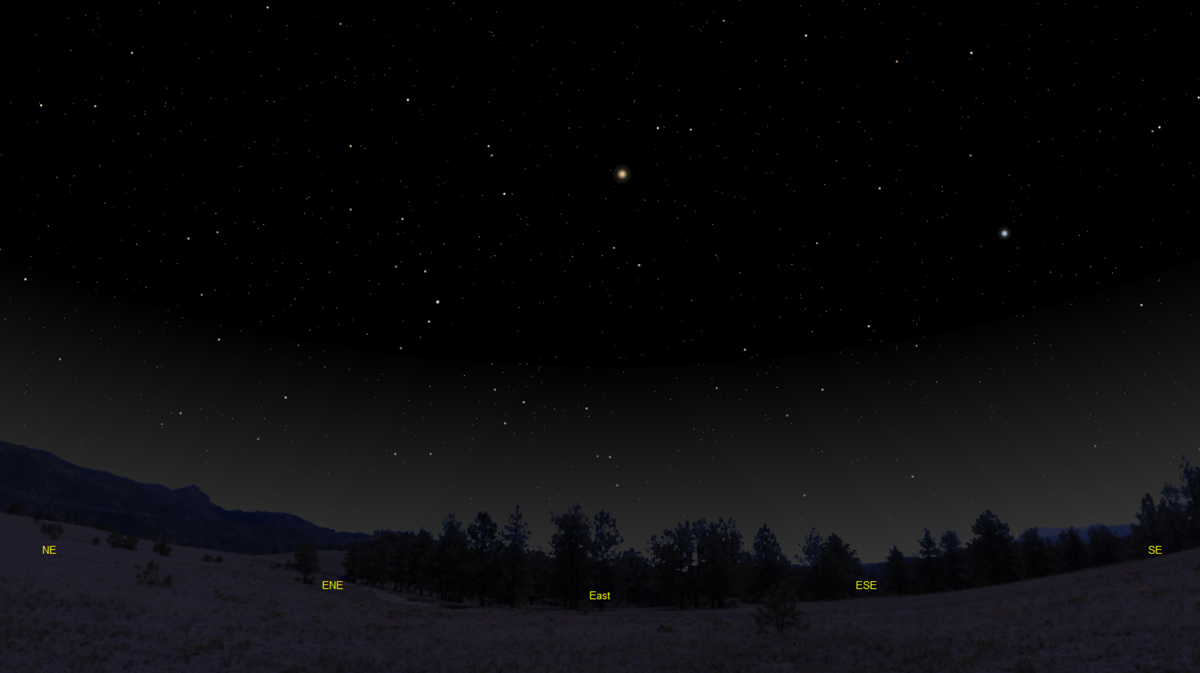The purpose of this feature is to give scout leaders, educators and naturalists an idea of some of the natural events coming up each month. We will try to cover a variety of natural events ranging from sky events to calling periods of amphibians, bird and mammal watching tips, prominent wildflowers and anything else that comes to mind. We will also note prominent constellations appearing over the eastern horizon at mid-evening each month for our area for those who would like to learn the constellations. If you have suggestions for other types of natural information you would like to see added to this calendar, let us know! Note: You can click on the hyperlinks to learn more about some of the featured items. To return to the Calendar, hit the "back" button on your browser, NOT the "back" button on the web page. All charts are available in a "printer friendly" mode, with black stars on a white background. Left clicking on each chart will take you to a printable black and white image. Though we link book references to nationwide sources, we encourage you to support your local book store whenever possible.
Notes From March 2020 During these trying times I find some peace in the natural world. In March, one by one, various wildflower species reintroduced themselves. I watched a Bald Eagle hunt the upper pond at Cloudland on the 13th. In the evenings the calls of Upland Chorus Frogs, Spring Peepers, Pickerel Frogs, Southern Leopard Frogs, and American Toads drifted up from the pond beside my house. By the end of the month Fowler's Toads and Eastern Cricket Frogs had joined the chorus. The great V's of Sandhill Cranes began to diminish, but by then spring migrants started to appear! We heard a Yellow-throated Warbler on March 6th, and on the 28th three Blue-winged Teal rose from the pond as I passed. Returning from a walk to my observatory later that day I was treated to a stunning view of a Vesper Sparrow. On March 26th, after much rain, I finally had a chance to do a little astrophotography. I decided to renew an old friendship with the Owl Nebula, Messier 97. The "Owl" and I go way back. Decades ago I decided to take a visual tour of the 110 Messier objects using an old 22 power, 60mm Bushnell spotting scope. The scope had a hard life, and had fallen over in creek beds all over the world. But it was easy to carry on camping trips, and I would leave the tent in the middle of the night sometimes to star-hop my way to a nebula or galaxy. I have many happy memories from that time. I kept a record of all of my observations, and it was a terrific way to gain some in-depth knowledge of the constellations. In my log I show that we viewed M97 from the Holly Flats campground near Tellico Plains, on March 31st, 1995. It was an exceptionally clear night, and I found several other Messier objects. I also managed to see the great edge-on galaxy NGC 4565 through my battered little scope. It was a beautiful evening, and the next morning we heard a Swainson's Warbler calling from the rhododendron. All of this made it fun to image the Owl Nebula this March. High wispy cirrus clouds drifted by on the evening of the 26th and wind gusts occasionally caused the telescope to lose its guide star. But it was so nice to be back under the stars! A Barred Owl encouraged me with its "Who cooks for you, who cooks for you-all" call from the woods south of the observatory. Eventually I accumulated enough exposure time to image his celestial counterpart.
The Owl Nebula is a planetary nebula. Planetary nebulae were so named because early observers thought they looked like dim planets. The Owl was discovered on February 16th, 1781 by French astronomer Pierre Mechain. Like Messier, he was primarily a comet observer, and his discovery was eventually included in Messer's catalog of objects to be avoided by comet seekers. It was first nicknamed the Owl Nebula by Lord Rosse, from a sketch he made of it in 1848 observing with his large reflector at Birr Castle in Ireland. I have seen the "eyes" in a very high-contrast six-inch refracting telescope, but haven't seen them with smaller apertures. Planetary nebulae have been called the wreaths nature places around dying stars. They are shells of gas that have been ejected from a star as it transitions from a hydrogen-burning main sequence star into a red giant and then eventually into a white dwarf. There are three concentric shells of gas that form the Owl Nebula. The innermost shell has a barrel like structure that is inclined 45 degrees to our line of sight. The translucent middle shell is easily seen in the image above. The very faint outer shell extends almost to the bright star above and to the right of the nebula, and is barely brighter than the surrounding stellar background. The shells are illuminated by the white dwarf at the center of the nebula. White dwarfs eventually cool to red dwarfs and then to black dwarfs, but this process takes billions of years.
Like most of us, I'm not wandering far from my house right now. But the half mile walk to my observatory can begin a journey more than halfway across the observable universe. My journeys into the microscopic world are no less interesting. Scott Russell Sanders said, "There are no privileged locations. If you stay put, your place may become a holy center, not because it gives you special access to the divine, but because in your stillness you hear what might be heard anywhere. All there is to see can be seen from anywhere in the universe, if you know how to look." Sky Events for April 2020:
Morning Sky :Jupiter rises about 3:38 a.m. EDT at the beginning of the month in Sagittarius. Waiting till just before dawn will give the best views telescopically.Saturn rises after Jupiter, about 4:10 a.m. EDT at the beginning of the month. It will start out the month below and to the left of Jupiter, just over the border between Sagittarius and Capricornus.Mars rises soon after Saturn, about 4:15 a.m. EDT, and will appear below and to the left of Saturn at the beginning of the month. It's still tiny in a telescope's field of view, with an apparent diameter of just 6.4 arc-seconds. If you look to the southeast horizon at the beginning of the month about 6:00 a.m. EDT, you can see all three planets. Evening Sky: Venus is the first star-like object to appear in the southwestern sky after sunset. It reaches its maximum brightness this month. The brilliant planet will pass close to the Pleiades on April 3rd, which should make for a pretty grouping.
The views below show the sky looking east at 10:15pm EDT on April 15th from the Chattanooga area. The first view shows the sky with the constellation outlined and names depicted. Star and planet names are in green. Constellation names are in blue. The second view shows the same scene without labels. Arcturus and Spica dominate the eastern sky this month. New constellations are Serpens Caput, the Serpent (Head), and Hercules, the Strongman. As spring progresses and Hercules rises higher in the sky, look for the globular cluster Messier 13, which appears like a small fuzzy patch of light about 1/3 of the distance from Eta to Zeta Hercules (see illustration below). A cluster of stars about 21,000 light years away, M13 can be made out with the naked eye in a dark country sky when the constellation is high in the sky. Binoculars will help pick it out. In small telescopes you can make out some stars around the edges of the cluster. It's a beautiful sight in a large telescope, and you can see a small shadowy three-sided feature (about the 4:00 o'clock position in the image at above) nicknamed "the propeller."
On Learning the Constellations: We advise learning a few constellations each month, and then following them through the seasons. Once you associate a particular constellation coming over the eastern horizon at a certain time of year, you may start thinking about it like an old friend, looking forward to its arrival each season. The stars in the evening scene above, for instance, will always be in the same place relative to the horizon at the same time and date each April. Of course, the planets do move slowly through the constellations, but with practice you will learn to identify them from their appearance. In particular, learn the brightest stars (Like Arcturus and Spica in the above scene looking east), for they will guide you to the fainter stars. Once you can locate the more prominent constellations, you can "branch out" to other constellations around them. It may take you a little while to get a sense of scale, to translate what you see on the computer screen or what you see on the page of a book to what you see in the sky. Look for patterns, like the stars that make up the constellation Corona Borealis. The earth's rotation causes the constellations to appear to move across the sky just as the sun and the moon appear to do. If you go outside earlier than the time shown on the charts, the constellations will be lower to the eastern horizon. If you observe later, they will have climbed higher. As each season progresses, the earth's motion around the sun causes the constellations to appear a little farther towards the west each night for any given time of night. If you want to see where the constellations in the above figures will be on May 15th at 10:15pm EDT, you can stay up till 12:15am EDT on the April 16th and get a preview. The westward motion of the constellations is equivalent to two hours per month. Recommended: Sky & Telescope's Pocket Star Atlas is beautiful, compact star atlas. A good book to learn the constellations is Patterns in the Sky, by Hewitt-White. For sky watching tips, an inexpensive good guide is Secrets of Stargazing, by Becky Ramotowski.
A good general reference book on astronomy is the Peterson
Field Guide,
A Field Guide to the Stars and Planets, by Pasachoff. The book retails for around $14.00.
The Virtual Moon Atlas is a terrific way to learn the surface features of the Moon. And it's free software. You can download the Virtual Moon Atlas here. Apps: We really love the Sky Safari 6 Pro. It is available for both iOS and Android operating systems. There are three versions. The Pro is simply the best astronomy app we've ever seen. The description of the Pro version reads, "includes over 100 million stars, 3 million galaxies down to 18th magnitude, and 750,000 solar system objects; including every comet and asteroid ever discovered." A nother great app is the Photographer's Ephemeris. Great for finding sunrise, moonrise, sunset and moonset times and the precise place on the horizon that the event will occur. Invaluable not only for planning photographs, but also nice to plan an outing to watch the full moon rise. Available for both androids and iOS operating systems.
Amphibians:
Recommended: The Frogs and Toads of North America, Lang Elliott, Houghton Mifflin Co. Archives (Remember to use the back button on your browser, NOT the back button on the web page!) Natural Calendar February 2020 Natural Calendar December 2019 Natural Calendar November 2019 Natural Calendar September 2019 Natural Calendar February 2019 Natural Calendar December 2018 Natural Calendar November 2018 Natural Calendar September 2018 Natural Calendar February 2018 Natural Calendar December 2017 Natural Calendar November 2017 Natural Calendar October 2017Natural Calendar September 2017 Natural Calendar February 2017 Natural Calendar December 2016 Natural Calendar November 2016 Natural Calendar September 2016Natural Calendar February 2016 Natural Calendar December 2015 Natural Calendar November 2015 Natural Calendar September 2015 Natural Calendar November 2014 Natural Calendar September 2014 Natural Calendar September 2013 Natural Calendar December 2012 Natural Calendar November 2012 Natural Calendar September 2012 Natural Calendar February 2012 Natural Calendar December 2011 Natural Calendar November 2011 Natural Calendar September 2011 Natural Calendar December 2010 Natural Calendar November 2010 Natural Calendar September 2010 Natural Calendar February 2010 Natural Calendar December 2009 Natural Calendar November 2009 Natural Calendar September 2009 Natural Calendar February 2009 Natural Calendar December 2008 Natural Calendar November 2008 Natural Calendar September 2008 Natural Calendar February 2008 Natural Calendar December 2007 Natural Calendar November 2007 Natural Calendar September 2007 Natural Calendar February 2007 Natural Calendar December 2006 Natural Calendar November 2006 Natural Calendar September 2006 Natural Calendar February 2006
Natural Calendar December 2005
Natural Calendar November 2005
Natural Calendar September 2005
Natural Calendar February 2005
Natural Calendar December 2004
Natural Calendar November 2004
Natural Calendar September 2004
Natural Calendar February 2004
Natural Calendar December 2003
Natural Calendar November 2003 Natural Calendar February 2003 Natural Calendar December 2002 Natural Calendar November 2002 Nature Notes Archives: Nature Notes was a page we published in 2001 and 2002 containing our observations about everything from the northern lights display of November 2001 to frog and salamander egg masses. Night scenes prepared with The Sky Professional from Software Bisque All images and recordings © 2020 Leaps
|
|






